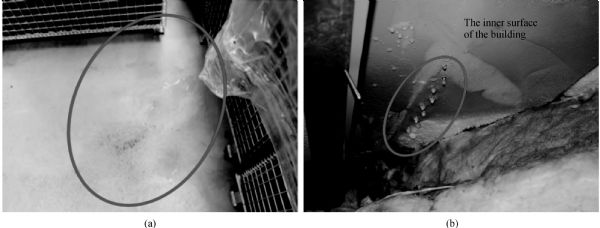

Influence of infiltration on energy consumption of a winery building
Received date: 15 Jul 2013
Accepted date: 09 Oct 2013
Published date: 05 Mar 2014
Copyright
With the wide use of light steel structure in industrial buildings, some problems such as air leakage, water dripping and condensation and so forth occur during the construction and operation phases. Through the onsite testing of a winery building in Huailai County, Hebei Province in China, the influence of infiltration on energy consumption in industrial buildings was studied. The pressurization test method and moisture condensation method were used to test the infiltration rates. The results show that the winery building is twice as leaky as normal Chinese buildings and five times as leaky as Canadian buildings. The energy use simulation demonstrates that the reduction of the infiltration rate of the exterior rooms to 1/3 and the interior rooms to 1/2 could help decrease a total energy consumption of approximately 20% and reduce a total energy cost of approximately $ 225000. Therefore, it has a great potential to reduce the energy consumption in this type of buildings. Enforcement of the appropriate design, construction and installation would play a significant role in improving the overall performance of the building.

Hejiang SUN , Qingxia YANG . Influence of infiltration on energy consumption of a winery building[J]. Frontiers in Energy, 2014 , 8(1) : 110 -118 . DOI: 10.1007/s11708-013-0293-3
| 1 |
Song X. The study on design of light steel industrial building. Dissertation for the Master’s Degree. Jinan: Shandong Jianzhu University, 2012, 1–100 (in Chinese)
|
| 2 |
Fennell H C, Haehnel J. Setting air tightness standards. ASHRAE Journal, 2005, 47(9): 26–30
|
| 3 |
Pan W. Relationship between air-tightness and its influencing factors of post-2006 new-built dwellings in the UK. Building and Environment, 2010, 45(11): 2387–2399
|
| 4 |
Woods T. Improving the building envelope to meet the challenges of new research and regulation. 2013-03-29
|
| 5 |
Chen S Q, Levine M D, Li H Y, Yowargana P, Xie L N. Measured air tightness performance of residential buildings in North China and its influence on district space heating energy use. Energy and Building, 2012, 51: 157–164
|
| 6 |
Kalamees T. Air tightness and air leakages of new lightweight single-family. Building and Environment, 2007, 42(6): 2369–2377
|
| 7 |
Emmerich S J, Persily A K. Air tightness of commercial buildings in the U.S. In: Proceedings of 26th AIVC Conference, Brussels, Belgium, 2005, 65–70
|
| 8 |
Fan Y Q, Hayashi T, Ito K. Coupled simulation of BES-CFD and performance assessment of energy recovery ventilation system for office model. Journal of Central South University, 2012, 19(3): 633–638
|
| 9 |
D’Ambrosio Alfano F R, Dell’Isola M, Ficco G, Tassini F. Experimental analysis of air tightness in Mediterranean buildings using the fan pressurization method. Building and Environment, 2012, 53: 16–25
|
| 10 |
Ministry of Housing and Urban-Rural Development of the People’s Republic of China, General Administration of Quality Supervision, Inspection and Quarantine. GB50411–2007 Code for Acceptance of Energy Efficient Building Construction. Beijing: China Architecture and Building Press, 2007 (in Chinese)
|
| 11 |
Ministry of Housing and Urban-Rural Deveiopment of the People’s Republic of China, General Administration of Quality Supervision, Inspection and Quarantine. GB50591–2010 Code for Construction and Acceptance of Cleanroom. Beijing: China Architecture and Building Press, 2010 (in Chinese)
|
| 12 |
Amin M, Dabiri D, Navaz H K. Tracer gas technique: A new approach for steady state infiltration rate measurement of open refrigerated display cases. Journal of Food Engineering, 2009, 92(2): 172–181
|
| 13 |
Ministry of Housing and Urban-Rural Development of the People’s Republic of China. JGJ/T177–2009 Standard for Energy Efficiency Test of Public Buildings. Beijing: China Architecture and Building Press, 2009 (in Chinese)
|
| 14 |
ISO. EN 13829–2000 Thermal performance of buildings- Determination of air permeability of buildings- Fan pressurization method. Britain: British Standard Institude, 2000
|
| 15 |
Tabares-Velasco P C, Christensen C, Bianchi M. Verification and validation of EnergyPlus phase change material model for opaque wall assemblies. Building and Environment, 2012, 54: 186–196
|
| 16 |
Zhai Z Q, Johnson M H, Krarti M. Assessment of natural and hybrid ventilation models in whole-building energy simulations. Energy and Building, 2011, 43(9): 2251–2261
|
| 17 |
ASHRAE. Chapter 16: Ventilation and infiltration. In: ASHRAE Handbook: Fundamentals. Atlanta: American Society of Heating, Refrigerating and Air Conditioning Engineers, 2009
|
/
| 〈 |
|
〉 |